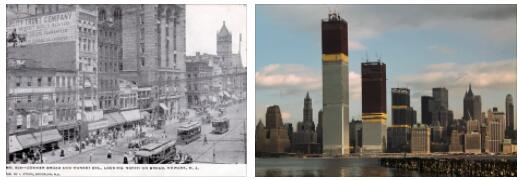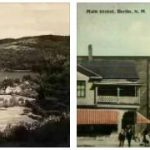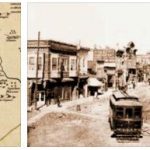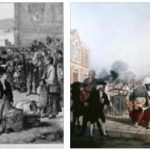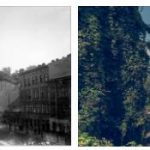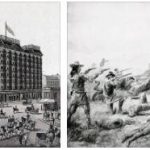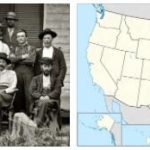Population: 8 821.155 thousand people (2011)
Area: 22608.0 sq. km
The state of New Jersey stretches along the Atlantic coast for 300 kilometers. Its natural boundaries are Delaware Bay and New York Harbor, and the Delaware (to the west) and Hudson (to the east) rivers. Despite its tiny (in comparison with other states) size, New Jersey has the highest population density in the country.
The relief in the state is flat. Only in the north are the hills of the Piedmont ridge of the Appalachian mountain range. The state lies in the temperate zone, but the proximity of the ocean causes a mild winter. It can be quite hot in summer, but heavy rainfall (more than 100 days a year) offsets significant temperature indicators.
New Jersey is nicknamed the State of Gardens, as the natural conditions are ideal for gardening, as well as vegetable growing and cattle breeding.
The lands of the state are the original place of residence of the Lenape (Delaware) Indians. In the 1630s, Dutch settlements and trading posts appeared on the coast. New Jersey was part of the vast Dutch colony of New Netherland. In 1664, the flotilla of Colonel R. Niccols entered New York Bay and captured the colony. In 1776, New Jersey was among 13 colonies that rebelled against the mother country and started the War of Independence. In this war, the territory of the state passed to the British and colonists several times, which was reflected in another nickname for New Jersey – “Crossroads of the Revolution”. New Jersey is the third US state (since 1787). The state government was the first (1789) to ratify the famous Bill of Rights document.
New Jersey is a famous resort area. The Atlantic coast is dotted with mansions and resort towns, especially in Cape May. The state has a well-established entertainment infrastructure: the state has children’s parks, safaris, an aquarium, a planetarium, historical parks. There are also many museums in New Jersey (the most famous is Newark with 80 halls), places associated with the War of Independence. Vineyards in Egg Harbor, a monument on the site of the highest point of the state and the Pinelands Reserve attract the attention of tourists. However, Atlantic City brought glory to the state – the famous casino city, an analogue of Las Vegas on the east coast.
ATLANTIC CITY
Population: 40.917 thousand people (2010)
Area: 53.4 sq. km
Time zone: UTC-5, summer UTC-4
City of Atlantic City famous as a resort and entertainment center. Its territory occupies the east coast of the United States and lies on a sandy island that stretches along the mainland for almost 13 kilometers. The recreation infrastructure began to develop here from the moment the city was founded. Now, in terms of its popularity in the gambling industry, it is second only to Las Vegas. It became most famous after the opening of a direct railway connection in the middle of the 19th century. Every year the number of vacationers arriving to rest in Atlantic City has grown inexorably. In the early stages of its development, the resort was a holiday destination mainly for tourists from neighboring Philadelphia. Its heyday came in the first half of the 20th century. In those days, every vacationer could find entertainment for an affordable price.
The legalization of gambling in 1976 was the start for the growing popularity of the resort. Since that period, the waterfront has been filled with several casinos, quickly attracting new audiences. According to statistics, Atlantic City is now visited by more than 35 million tourists annually. The most famous historical place in the city is the embankment paved with wooden boards, stretching for more than 6 kilometers. Its original purpose was to remove sand from areas close to hotel entrances. Now the embankment with a historical past is the most popular vacation spot for city guests. Many city attractions are concentrated here and nightlife is in full swing.
Not so long ago, after restoration, the Absecon Lighthouse was opened for study tours. Fascinating mini trips across the ocean coastal expanses are made on yachts and boats. For lovers of shopping, a huge shopping complex is a fascinating tour of numerous boutiques. There are 125 stores with a variety of collections of clothes, shoes, jewelry, souvenirs from well-known manufacturers with a worldwide reputation. The world of tropical fish and coral reefs opens in the local aquarium, where their numerous species live.
JERSEY CITY
Population: 242.389 thousand people (2007)
Area: 54.7 sq. km
Time zone: UTC-5, summer UTC-4
Altitude: 9 m
Zip code: 07300, et al.
Jersey City is the second largest city in New Jersey. It adjoins Manhattan Island in New York, separated by the Hudson River. The western boundary of Jersey City is the Hackensack River. In the southeast, the city is washed by the waters of Upper Bay.
Before the arrival of the whites, these lands were the fiefdoms of the Delaware Indians. In 1609, the expedition of Henry Hudson arrived here (the Hudson River is named after him). In 1630, the first English settlement appeared. Some time later, the Dutch owned the colony, calling the settlement Pavonia. At the same time, the historical center was formed – Bergen Square with the surrounding streets and quarters. Jersey City became a city in 1820, having survived the troubled times of the wars with the Indians and British troops. Now the city has developed electrical, chemical and food industries.
Few people know that the famous Statue of Liberty, the symbol of New York and the United States, is actually located on the territory of Jersey City. However, the city is also famous for the 15-meter octagonal Colgate dial, 18th century mansions, the large Liberty Science Center and the impressive railway station building. Besides. In Jersey City there is a memorial to the victims of Katyn. The 10-meter statue is dedicated to the Poles who were shot near the village of Katyn (Smolensk region) in 1940.
Jersey City has a fairly active cultural life. There are many museums (one of them is a museum of Russian unofficial art), libraries. The Shakespeare Festival takes place every year during the summer. Performances and readings are held outdoors in the parks of Jersey City.
Elizabeth, New Jersey
History and Climate of Elizabeth, New Jersey:
History: Elizabeth, New Jersey, is a city with a deep and diverse history that spans centuries, making it one of the oldest cities in the United States. Named after Elizabeth Carteret, the wife of Sir George Carteret, one of the original Proprietors of New Jersey, the city’s history is closely intertwined with the broader narrative of the American colonies.
The city was first settled in the 1660s, and by 1665, it became one of the original 13 English colonies. Elizabeth played a significant role during the American Revolutionary War, with notable events such as the Battle of Elizabethport taking place in the vicinity. The city’s strategic location along the waterfront contributed to its importance in trade and commerce during the colonial era.
In the 19th century, Elizabeth underwent industrialization, and its port became a crucial transportation hub. Factories and mills sprang up, and the city’s population grew as immigrants arrived seeking employment opportunities. Elizabeth continued to evolve as a diverse and vibrant community, attracting people from various backgrounds.
The city has a rich architectural heritage, with structures representing different periods of American history. Historic sites like the Snyder Academy of Elizabethtown, dating back to 1768, and the Boxwood Hall, once home to Elias Boudinot and later George Washington, reflect the city’s colonial past.
Today, Elizabeth stands as a thriving urban center, encompassing a mix of residential, commercial, and industrial areas. Its history is celebrated through various cultural events, museums, and preservation efforts to maintain its historic character.
Climate: According to Baglib, Elizabeth experiences a humid subtropical climate, characterized by distinct seasons with variations in temperature and precipitation.
- Summer (June-August): Summers in Elizabeth are warm to hot, with average high temperatures ranging from the mid-70s to mid-80s Fahrenheit. Humidity levels can be noticeable during this season. Residents and visitors often enjoy outdoor activities in the city’s parks and along the Elizabeth River waterfront.
- Fall (September-November): Fall brings cooler temperatures, with average highs ranging from the mid-60s to mid-70s Fahrenheit. The city’s parks and green spaces showcase the changing colors of autumn foliage, providing a picturesque backdrop. Fall festivals and events are popular in the community.
- Winter (December-February): Winters in Elizabeth are cold, with average high temperatures ranging from the mid-30s to mid-40s Fahrenheit. Snowfall is common, and the city experiences a winter chill. Residents engage in winter sports and celebrate the holiday season with festive decorations and events.
- Spring (March-May): Spring is a transitional season marked by rising temperatures, with average highs ranging from the mid-50s to mid-60s Fahrenheit. As flowers bloom and trees leaf out, the city experiences a renewal of life. Spring is an ideal time for outdoor activities and community gatherings.
The city’s proximity to the Atlantic Ocean influences its climate, moderating temperature extremes and contributing to the overall mildness of the seasons.
Elizabeth’s climate and historical significance contribute to its appeal as a diverse and dynamic urban center. The city’s commitment to preserving its history, combined with ongoing development initiatives, creates a blend of old and new that defines Elizabeth’s character in the 21st century.
